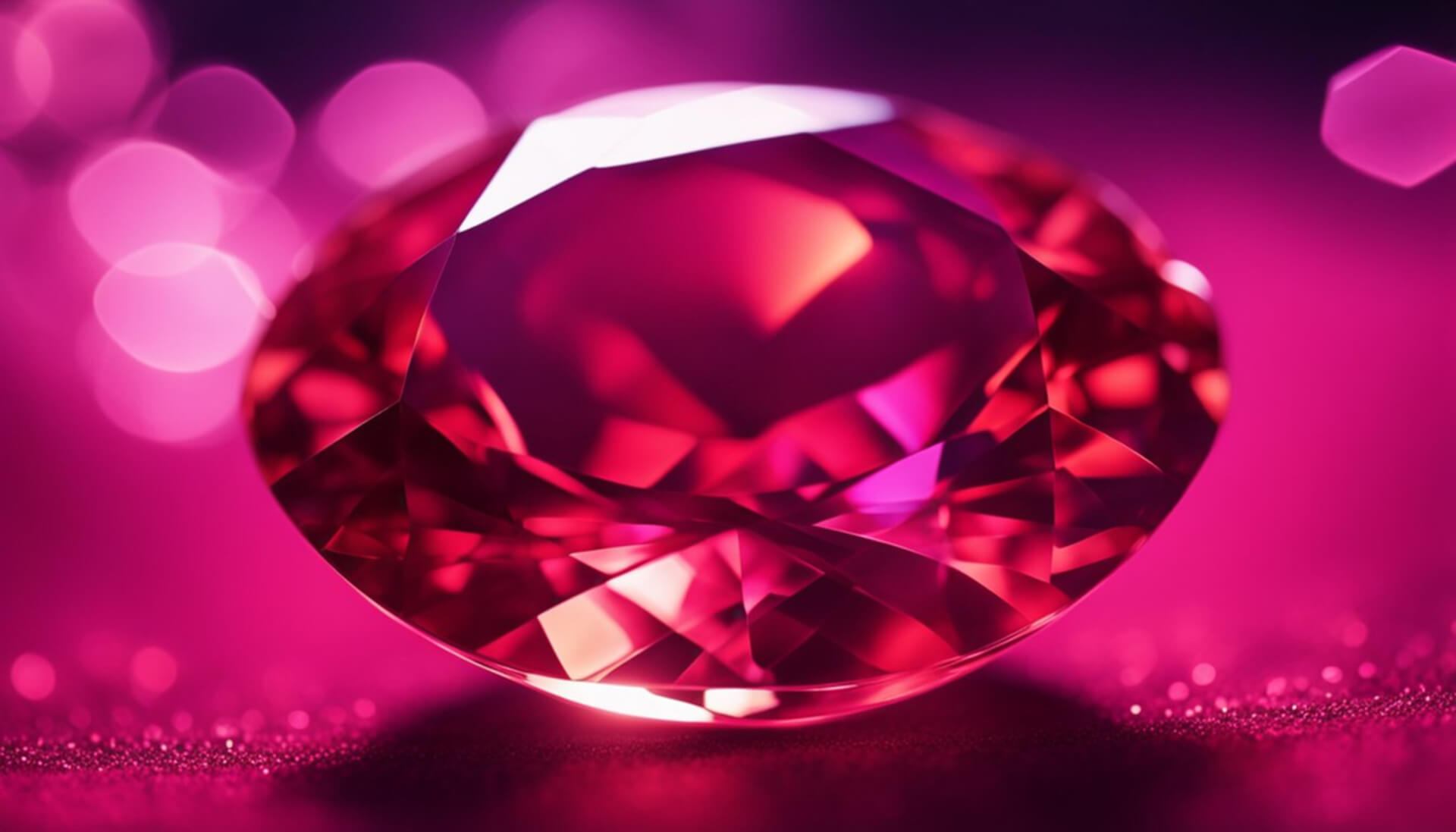The July birthstone is synonymous with the rich, red hue of the ruby, a gemstone highly prized throughout history. Rubies epitomize passion, love, and vitality. Their vibrant color and exceptional hardness make them one of the most desirable gemstones for jewelry.
Believed to bring good fortune and protection to those born in July, rubies are a mark of celebration and a symbol of enduring strength.
Regarding quality and value, rubies are judged based on color, clarity, cut, and carat weight.
The most sought-after rubies have a deep, vivid red color, often called “pigeon’s blood.”
The sources of high-quality rubies include countries such as Myanmar, Thailand, and Madagascar.
People opt for ruby jewelry not just for the charm of their appearance, but also because they’re a durable gemstone. Rubies are second only to diamonds in hardness, making them an excellent choice for everyday wear.
The Significance of July Birthstone
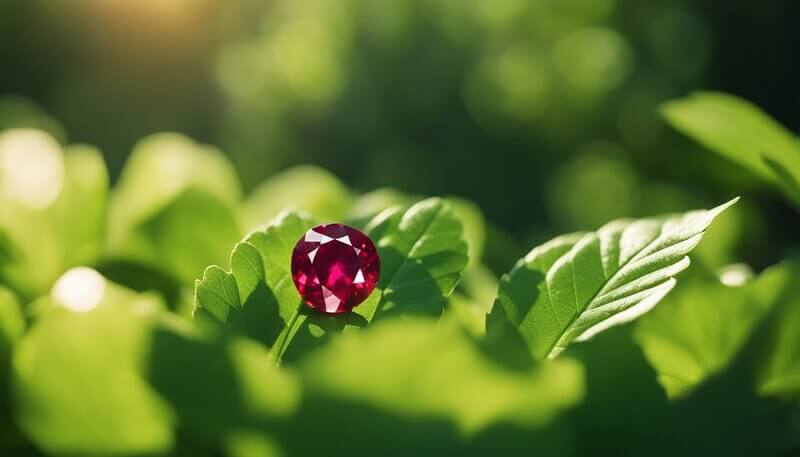
The July ruby birthstone is traditionally associated with passion, protection, and prosperity.
Its rich red hue has captivated many cultures throughout history, linking it to the heart of many tales and traditions.
Historical Background
Rubies have been revered since ancient times.
The ancient Hindus called the ruby the “king of gems,” valuing it for its ability to ward off evil.
The Medieval European literature speaks of the stone’s healing and protective properties, while the ancient Romans and Greeks associated it with power and love.
Notably, the Archduchess Maria Anna of Austria was known to have a famous ruby jewelry collection, reflecting the gemstone’s status among royalty.
Cultural and Astrological Meanings
In astrology, ruby is linked to the Cancer and Leo zodiac signs.
Astrologers often attribute qualities such as love, passion, and courage to those born under these signs, resonating with the stone’s symbolism.
Rubies are believed to protect the wearer, promote good fortune in relationships, and enhance luck.
Birthstone by Month Relevance
Each month is represented by a specific birthstone, with ruby standing for July.
The tradition of birthstones can be traced back to ancient civilizations, where they were thought to hold power and wisdom.
Rubies, particularly, are tied to success, a sentiment that spread from Hinduism into global cultures, leading to their enduring popularity.
Modern Associations and Symbolism
Today, rubies continue to symbolize wealth, success, and courage.
Modern interpretations often link them to passion and vitality, making them popular gifts for representing both romantic and platonic love.
Rubies remain one of the most sought-after gemstones, coveted for their deep red color and association with joy and good fortune.
Characteristics of Ruby Gemstone
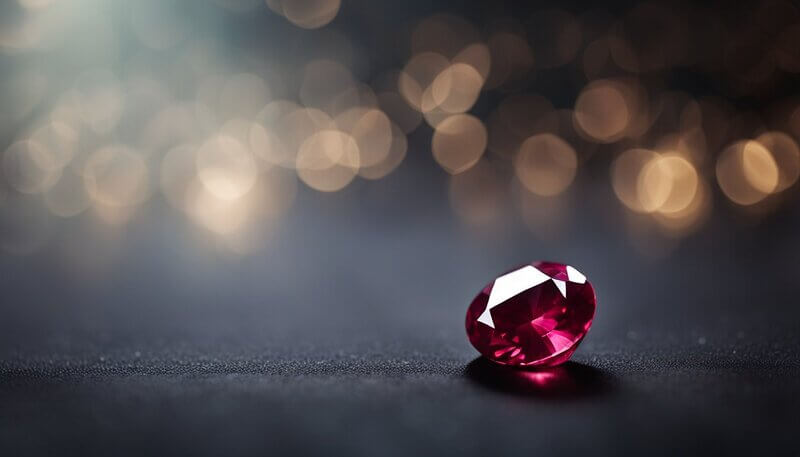
The ruby gemstone is renowned for its vivid red color and exceptional hardness, making it a coveted jewel for centuries.
Physical Properties of Ruby
Ruby is a crystal that ranks 9 on the Mohs scale of mineral hardness, making it one of the hardest natural gemstones, second only to diamonds.
The presence of chromium within the mineral corundum is responsible for the red color of rubies.
Ruby’s clarity can range significantly, with the most sought-after stones displaying high transparency and minimal inclusions.
The quality and cut of a ruby can greatly affect its appearance and value.
Ruby Varieties and Color Spectrum
The color of ruby gemstones can vary from pink to blood-red, often called pigeon blood.
Red rubies are the most prized, and their value diminishes as the color lightens toward pink or deepens toward brownish-red.
Ruby’s captivating color spectrum is complemented by its pleochroism, which can display different colors depending on the angle from which it is viewed.
While all red corundum gemstones are classified as rubies, pink varieties can sometimes be confused with pink sapphires, which are also corundum.
Ruby Care and Maintenance
Rubies require careful maintenance to preserve their luster and form.
They should be cleaned with a mild soap solution and a soft brush to protect their finish.
Ruby gemstones are also sensitive to high temperatures and harsh chemicals, which can damage their structure and color.
It’s recommended to store rubies away from other gemstones to prevent scratches and maintain their beauty.
Regular professional cleaning and inspection can help sustain the ruby’s brilliance and structural integrity.
Ruby Origins and Sources
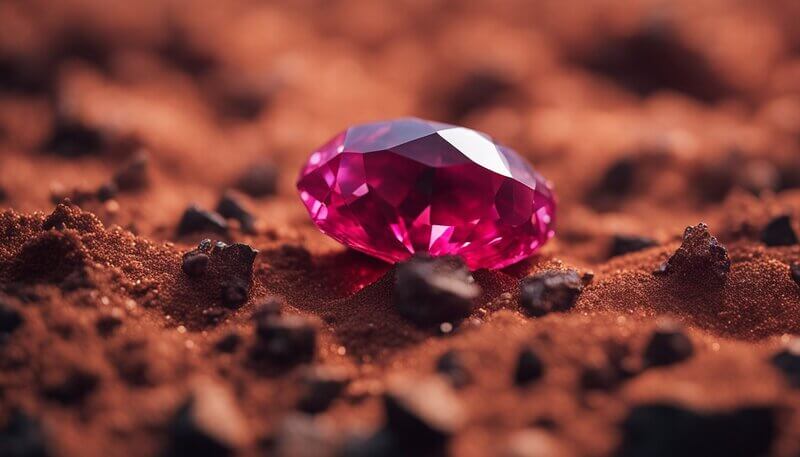
Rubies have a rich history and are primarily sourced from various locations globally, known for their vibrant red color and rarity.
Historical Mining Locations
India historically was one of the earliest sources of rubies.
Mogok Valley in Myanmar (Burma), famed for the prized pigeon blood ruby, has been a significant mining area for centuries. These Burmese rubies are renowned for their exceptional quality.
Current Global Ruby Deposits
Today, ruby deposits are found in countries beyond Myanmar, including Mozambique, known for large deposits, and Thailand, noted for its dark, red-brownish rubies.
Other countries with notable ruby deposits include Madagascar, Tanzania, and Vietnam.
Economic and Environmental Impact
The extraction of rubies can have considerable economic benefits for mining regions, providing jobs and contributing to local economies.
However, there is also an environmental impact, ranging from habitat destruction to water pollution.
Operations must engage in responsible mining practices to minimize these effects.
Ruby in Jewelry
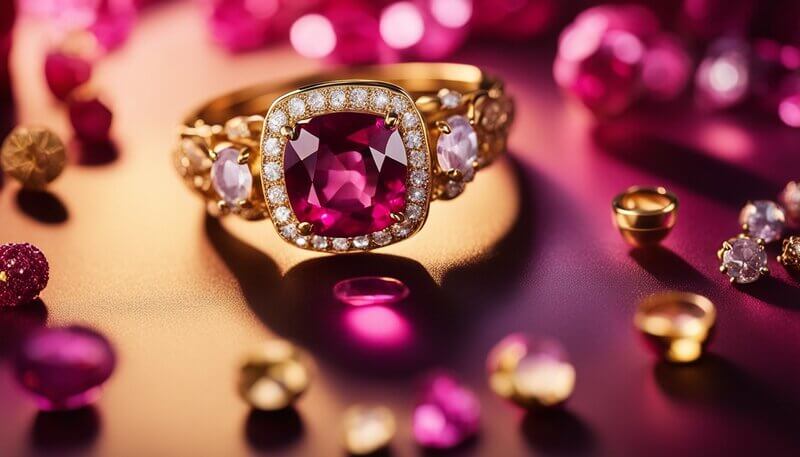
Ruby, cherished for its deep red hue and exceptional hardness, is prominently in birthstone jewelry and is a favorite choice for those born in July.
It’s comparable in hardness to sapphire and nearly as tough as diamond, making it an enduring gemstone for daily wear.
Design and Fashion Trends
Current fashion trends often showcase rubies in vintage-inspired settings or as central pieces in modern minimalist designs.
Designers emphasize the ruby’s rich color by pairing it with simple lines or intricate detailing. Rubies are frequently combined with diamond accents to enhance their natural beauty.
Setting Types and Metal Pairings
Rubies are versatile and can be set in various settings, from prongs that allow maximum light entry to bezel settings for protection.
They are striking when set in yellow gold, which amplifies their warmth, or white gold and platinum, which provide a beautiful contrast to their intense color.
In terms of popularity, the solitaire and halo settings showcase the ruby’s allure.
- Prongs: This setting type elevates the ruby, allowing light to enter and maximize the stone’s brilliance.
- Bezel: Encircling the ruby, this setting offers protection and is ideal for a sleek, modern look.
- Solitaire: Celebrated for its simplicity, it allows the ruby to be the focal point.
- Halo: A ring of smaller diamonds or gemstones encircles the ruby, making it appear larger and more luminous.
Evaluating Ruby Jewelry
One should consider the carat weight when evaluating ruby jewelry, as larger rubies are rarer and more valuable.
The most sought-after rubies are those with vibrant, saturated colors and minimal inclusions.
Unlike diamonds with a standardized grading system, assessing rubies can be more subjective and requires a knowledgeable eye.
Purchasing Ruby Gemstones
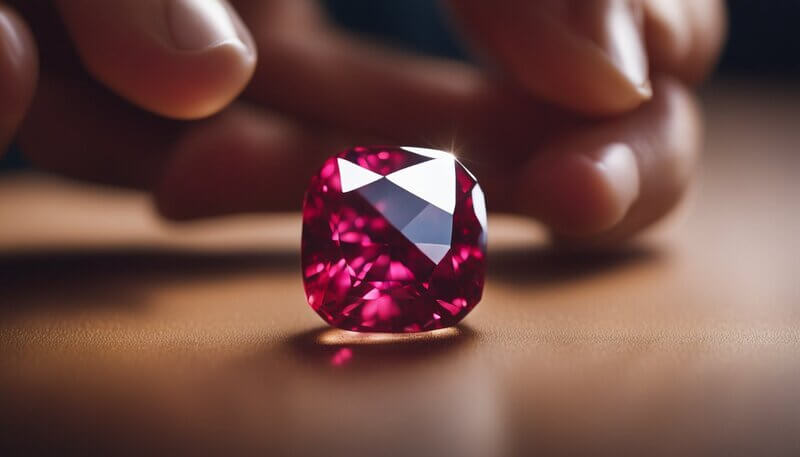
When buying a ruby gemstone, key considerations include its value determinants—such as carat, clarity, cut, and color—and understanding treatments and enhancements that may affect its authenticity and investment potential.
Determining Ruby Gemstone Value
It is imperative to consider several factors that contribute to a ruby’s value.
The most sought-after rubies are known for their vibrant “pigeon’s blood” color, which commands a premium in the market.
The four main criteria to evaluate a ruby are:
- Carat: Larger rubies are rare, which makes them more valuable.
- Clarity: The clarity of a ruby can greatly impact its value. Rubies without visible inclusions are more desirable.
- Cut: A well-cut ruby will exhibit superior brilliance and maximize the gemstone’s color.
- Color: Color is the most significant factor determining a ruby’s value. The most prized rubies have a rich, saturated red color with no overtones of brown or blue.
For assurance of quality and authenticity, prospective buyers should seek rubies accompanied by a certificate from a reputable gemological laboratory.
Ruby Treatments and Enhancements
Most rubies on the market have undergone treatment to enhance their color or clarity. Common treatments include:
- Heat Treatment: Enhances color and clarity. It is generally accepted in the market if disclosed.
- Lead Glass Filling: Improves apparent clarity. However, these rubies are less durable and valuable.
Purchasers should inquire whether a ruby is natural or treated. This will affect its value and potential as an investment. A reputable seller should disclose all treatments or enhancements, allowing the buyer to make an informed purchase.
Frequently Asked Questions
The July birthstone, recognized for its rich red hue, symbolizes passion and vitality. This section addresses common queries about its significance, jewelry usage, color association, alternatives, unique characteristics, and the plurality of birthstones for a given month.
1. What is the significance of the July birthstone?
The July birthstone, the ruby, is traditionally believed to represent love, health, and wisdom. Wearing a ruby is often thought to bring good fortune and protection to the wearer.
2. Which types of jewelry are commonly made with the July birthstone?
Rubies are frequently set in various types of jewelry, including rings, necklaces, bracelets, and earrings. Due to their durable nature, rubies are well-suited to fine jewelry.
3. What color is typically associated with the July birthstone?
The color of a ruby, July’s birthstone, is typically a vibrant red. This distinguishes it from other gemstones, such as the garnet, which has a deeper red shade.
4. Are there alternative gemstones associated with July for those seeking variety beyond the traditional stone?
While rubies are the most commonly recognized birthstone for July, some alternative red gemstones like spinel offer a variety for those seeking different options.
5. What characteristics make the July birthstone unique compared to other months’ stones?
Rubies possess exceptional hardness, second only to diamonds, making them highly durable. Their striking color and rarity also contribute to their uniqueness.
6. Can a month have more than one birthstone, and if so, which month does?
Yes, some months have more than one birthstone to provide options in color and price point.
While July is traditionally associated with the ruby, June, for example, is known to have multiple birthstones, including pearl, moonstone, and alexandrite.

